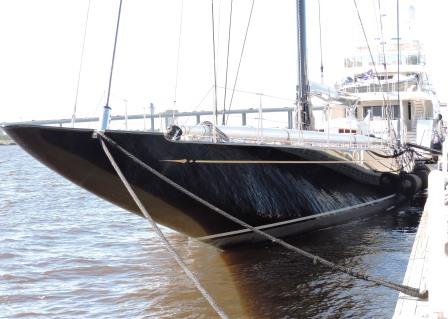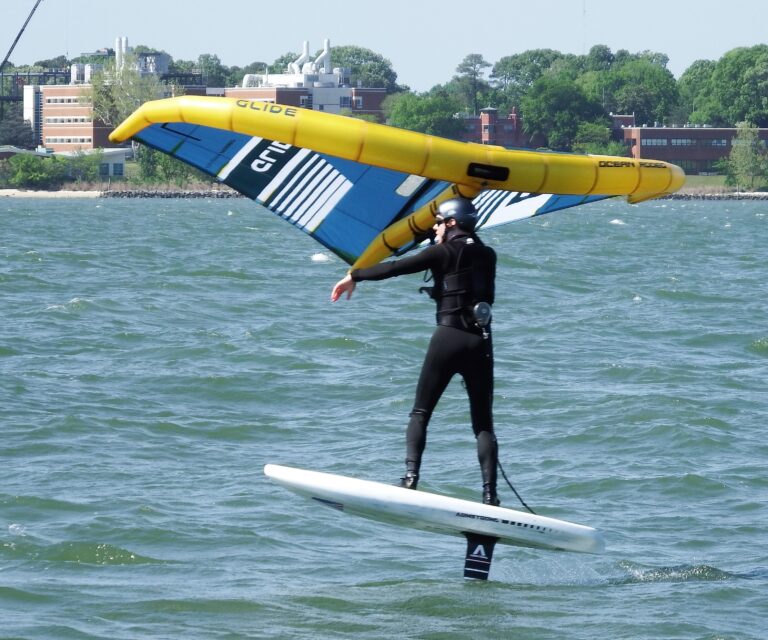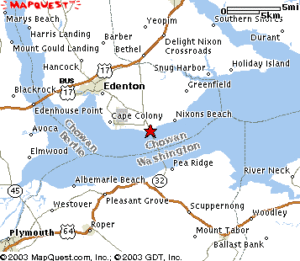
Hurricane Matthew was unusual for how the damage occurred. Typically a hurricane batters the coast and diminishes as it heads inland. In this case, the outer bands of rain pummeled central North and South Carolina with up to 9 inches of rain, cutting off roads with high water that crested to 28 feet above normal in some places. Those same bands of rain took days to reach swollen rivers, but the coast was clear from the effect of the tides pulling out the water. That’s where we were, on the coast.
Edenton
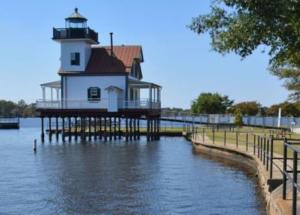 Our first stop was Edenton, where the Albemarle Sound rolled into the town with three-foot waves. The lower end of the town lies three feet above sea level, just enough to keep nearly every store and restaurant high and drive. A few days after the storm, we blew into town and started at the famed 1886 lighthouse. Nearby I found a charter captain with a small electric tug that he takes tourists out on.
Our first stop was Edenton, where the Albemarle Sound rolled into the town with three-foot waves. The lower end of the town lies three feet above sea level, just enough to keep nearly every store and restaurant high and drive. A few days after the storm, we blew into town and started at the famed 1886 lighthouse. Nearby I found a charter captain with a small electric tug that he takes tourists out on.
He said, “I couldn’t do this with a gasoline or diesel engine because there isn’t enough traffic to warrant that. We operate mainly in the summer. There’s a sailboat charter captain in town who includes it with his B&B. You take a room and he takes you sailing the next day. He has two sailboats actually. But he’s been doing it less and less because his wife took ill and he’s looking after her.”
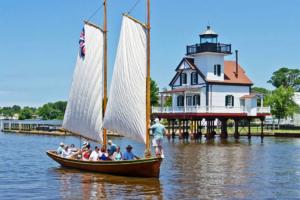 We found two beautiful homes on the water street that were perilously close to flooding. The sound crept up to two sides of each house, within 50 feet each. It looked harrowing if another storm was imminent. A few miles down the sound we found a marina with derelict sailboats and motorboats. It was sad.
We found two beautiful homes on the water street that were perilously close to flooding. The sound crept up to two sides of each house, within 50 feet each. It looked harrowing if another storm was imminent. A few miles down the sound we found a marina with derelict sailboats and motorboats. It was sad.
The one bright spot was the town itself, friendly and beautiful. The Granville Queen Inn where we stayed is elegant and comfortable. It dates to 1907.
New Bern
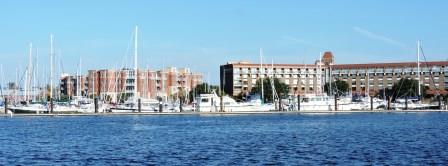
Farther down the coast lies the dynamic town of New Bern, where of all places a Federal Circuit Court lies. This is perhaps owing to New Bern’s history as an early settlement and town in the 1700s. The place was crawling with lawyers and yard signs for judges. The water community is based at the Neuse River.
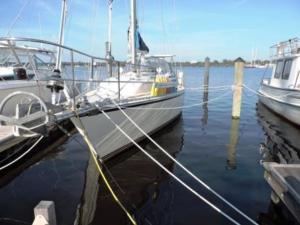 The main marina is close to town, behind a Doubletree hotel and the New Bern Grand Marina Yacht Club. I went inside and introduced myself as a charter captain scouting the territory, but that didn’t help me get the combinations to the dock from the lovely woman in charge. I went down anyway and soon discovered it was 1-2-3-4. Imagine that.
The main marina is close to town, behind a Doubletree hotel and the New Bern Grand Marina Yacht Club. I went inside and introduced myself as a charter captain scouting the territory, but that didn’t help me get the combinations to the dock from the lovely woman in charge. I went down anyway and soon discovered it was 1-2-3-4. Imagine that.
It was clear that New Bern was used as a hurricane hole during Matthew. While many boats were double-lined for safety, many more were big enough to single-line. I came across a fell from Virginia Beach on a Hunter 370, playing his guitar.
Florida damage
“I was on my way south to Jacksonville when I ducked in here for the storm. I heard that Conch Marina at St. Augustine was hit hard. Nine boats sunk and 20 others broke their moorings and wound up on the rocks. I tied mine up here and went back to Virginia Beach. From my computer I could access the CCTV cameras to watch the storm’s effects. I couldn’t see my particular boat but I could tell from the rocking that everyone was going to be okay.
“They say the Intercoastal Waterway is silted in worse in Georgia than normal, with more sandbars. I may be here for a month because I’m not going to sail outside [the ICW]. We’re fine here, but the question is what’s in the water.” It looked black, just as it did in Edenton.
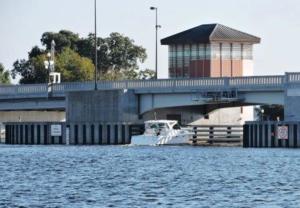 New Bern looks like a happening place, but no one could tell me the number of visitors who arrive each season. Two large marinas lie behind a highway, requiring an elaborate ballet of the drawbridge numerous times a day. Only small motorboats can transit otherwise. The good part, though, is that the causeway and surrounding buildings form an excellent breakwater against any storm and from the east and north.
New Bern looks like a happening place, but no one could tell me the number of visitors who arrive each season. Two large marinas lie behind a highway, requiring an elaborate ballet of the drawbridge numerous times a day. Only small motorboats can transit otherwise. The good part, though, is that the causeway and surrounding buildings form an excellent breakwater against any storm and from the east and north.
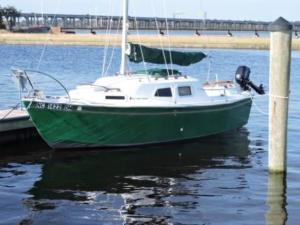 At the smaller Bridge Pointe Marina, dock manager Jesse Schumacher said the bulkheads were never breached, because of the tidal effect. I found a small green boat that resembled our 16-foot Newport/Gloucester. We got it when our girls were young and called it Wendin, for Wendy and Robin. Today that’s the name of the charter company.
At the smaller Bridge Pointe Marina, dock manager Jesse Schumacher said the bulkheads were never breached, because of the tidal effect. I found a small green boat that resembled our 16-foot Newport/Gloucester. We got it when our girls were young and called it Wendin, for Wendy and Robin. Today that’s the name of the charter company.
The comparable sailing charter I found was on the Bolero, a two-masted ship that sails in the afternoon and at sunset for $20 each. It looked like it could handle 25 people easily. The competitor is the 41-foot Two Peas, part of Palm Coast Tours & Sailing.
Washington
Here was our first real encounter with the impact of Matthew. The Tar River runs through Washington. It looked fine to me except for a wicked current. I asked a local about it and he pointed, “See that blue sailboat out there, moored in the river? Yesterday the current was creating as a wake.”
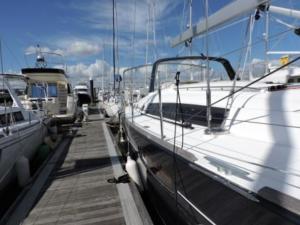 Having never seen the river before, I was surprised to learn it was five feet over normal—and rising. Three days after the hurricane, the drenching water was still draining well inland. The only thing that saved Washington from major flooding was the tide. One fellow told me, “It doesn’t matter how much rain we get. The water will spread out into the sound,” whose height is driven by the Atlantic tides.
Having never seen the river before, I was surprised to learn it was five feet over normal—and rising. Three days after the hurricane, the drenching water was still draining well inland. The only thing that saved Washington from major flooding was the tide. One fellow told me, “It doesn’t matter how much rain we get. The water will spread out into the sound,” whose height is driven by the Atlantic tides.
The only visible charter was the Jeanne B., a two-masted, 72-foot ketch billed as a schooner. It offers a three-hour tour for $25 per person. Paul and his three crew members all hold captain’s licenses. Guests are allowed to take them helm, just as they are on my boat. They offer sunset cruises as well, though no one was around perhaps because of the aftermath of the storm.
Beaufort
Farther south we found BOW-fert as part of the Crystal Coast of Atlantic Beach, Morehead City, Carrot Island and Beaufort. Everything is spread out in what resembles Myrtle Beach for massive size. Yet no one could tell me how many visitors they get or what the season is except “summer.”
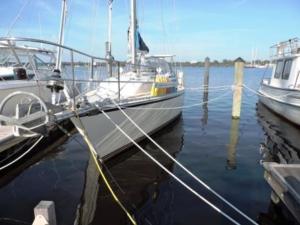 I found several charter boats of varying sizes. The most promising was a sloop, but it wasn’t at the dock. Two boats down, a young woman said her big catamaran Lookout makes three trips a day with 30 people including a sunset cruise. “The first two are captain’s choice, depending on the wind direction.” I liked that term, a big improvement over the golf connotation. She said of the sloop, “Captain Ron is an asshole. Please buy his boat. He’s never here and he can’t be reached by phone.”
I found several charter boats of varying sizes. The most promising was a sloop, but it wasn’t at the dock. Two boats down, a young woman said her big catamaran Lookout makes three trips a day with 30 people including a sunset cruise. “The first two are captain’s choice, depending on the wind direction.” I liked that term, a big improvement over the golf connotation. She said of the sloop, “Captain Ron is an asshole. Please buy his boat. He’s never here and he can’t be reached by phone.”
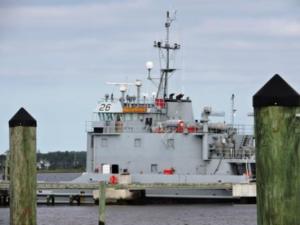 Elsewhere big fishing boats abound for offshore charters. A giant Navy ship called Matamoros was docked at a commercial dock, but I couldn’t find any research on it.
Elsewhere big fishing boats abound for offshore charters. A giant Navy ship called Matamoros was docked at a commercial dock, but I couldn’t find any research on it.
We crossed inland to South Carolina, and along the way we passed through many flooded areas of the Great Pee Dee River basin. Nearly a week after the storm there were still houses and churches with water standing halfway up the first story. No one was around, having long been evacuated. Inexplicably herds of deer were dead on the side of the road, three or more at a time.
The Washington Post reported that the preponderance of the communities hit hard were lowlands owned or occupied by poor farmers and families. “In some flooded communities, like Lumberton, the disaster also struck along racial lines: A white area of town was preserved, while a lower-lying African-American part now stood with several feet of water.”
Beaufort too
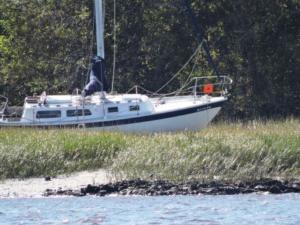 Then in South Carolina we arrived at BUE-fert at high tide, a seven-foot rise that went two feet higher in the storm before receding. We were told that several boats broke their moorings and wound up in the rushes. The dock was a floating type, and judging from the deck it may have been the first one built 25 years ago. The wood was torn and dangerous. One sailor said he came through just fine. Others were unbinding their boats.
Then in South Carolina we arrived at BUE-fert at high tide, a seven-foot rise that went two feet higher in the storm before receding. We were told that several boats broke their moorings and wound up in the rushes. The dock was a floating type, and judging from the deck it may have been the first one built 25 years ago. The wood was torn and dangerous. One sailor said he came through just fine. Others were unbinding their boats.
That evening, our friends Maxine and Benton Lutz described how friends of theirs moved both cars to avoid getting hit by a big tree. They parked next to each other around the corner in a parking lot. “Another big tree fell across both of them, destroying both cars,” Benton said. “The lesson learned is to park the cars away from each other so that if the tree falls it can’t ruin both of them.”
As a venue for sailing charters, it seemed shy on critical mass for tourists. The seven-foot tides would play havoc with a 32-foot Hunter.
Charleston
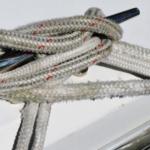 Here was the largest assembly of boats on the entire trip. People were busy unpacking their boats from Matthew. The rapid current of the Ashley River ensured a hasty exit of upriver downpours. A few signs were evident of the storm. One dock line looked severely chafed, though that could have predated Matthew.
Here was the largest assembly of boats on the entire trip. People were busy unpacking their boats from Matthew. The rapid current of the Ashley River ensured a hasty exit of upriver downpours. A few signs were evident of the storm. One dock line looked severely chafed, though that could have predated Matthew.
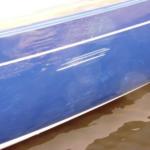 Another sailboat had a fresh gash from hitting the dock.
Another sailboat had a fresh gash from hitting the dock.
Nearby, one fellow said, “Charleston wasn’t hit as bad as Hilton Head. Harbor Town not so much, but Palmetto Bay had three boats destroyed.” Nearby, a fellow was dragging a line next to his dock. “It’s a grappling hook,” he said grimly. “I’m trying to find a bicycle.”
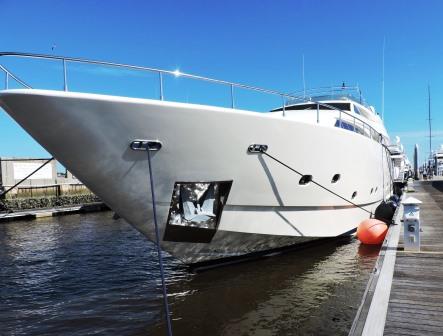
Mega-yachts
Gigantic mega-yachts were tied on a half-mile dock. People were storing their bicycles and moving smaller boats around. One threesome was playing poker on the deck.
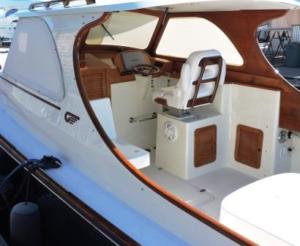 Next, a magnificent Hinckley yacht from Fayetteville was tied up behind a houseboat. The guy on the back of the houseboat said the Hinckley came in from somewhere else to use Charleston as a hurricane hole. “The marina near the Hinckley plant was destroyed, so I’m not sure if they brought this boat here. Hinckley isn’t a very practical boat, but it’s lovely.” I responded, “Yes, like a second wife.” He laughed.
Next, a magnificent Hinckley yacht from Fayetteville was tied up behind a houseboat. The guy on the back of the houseboat said the Hinckley came in from somewhere else to use Charleston as a hurricane hole. “The marina near the Hinckley plant was destroyed, so I’m not sure if they brought this boat here. Hinckley isn’t a very practical boat, but it’s lovely.” I responded, “Yes, like a second wife.” He laughed.
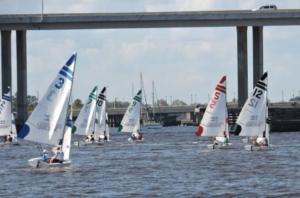 Then a regatta of small boats came sailing up the Ashley with the current, zipping past all the yachts as if there had never been a storm.
Then a regatta of small boats came sailing up the Ashley with the current, zipping past all the yachts as if there had never been a storm.
Going home
On the way home, we found I-95 newly open from the state line past Fayetteville after having been closed for a week. We crossed the ominous Lumber River and Tar River, which were still plenty high but below their banks.
My business conclusion is that it will take more scouting to find a venue as good as Williamsburg and Gloucester Point. We have ready access to the water at the excellent York River Yacht Haven. We have a built-in marketing dynamo by Busch Gardens and Colonial Williamsburg that brings in 2-3 million people year-round. Those are compelling factors. It’s good to be home.
Let’s Go Sail
Check rates and pick a day for a sailboat charter. See reviews on Trip Advisor from sailors like you.
